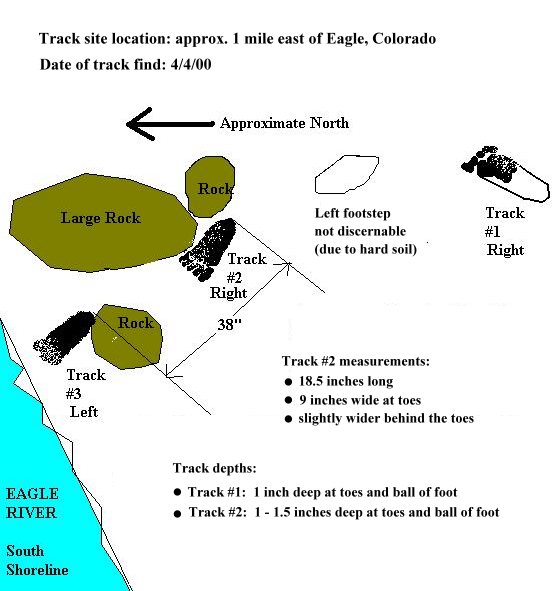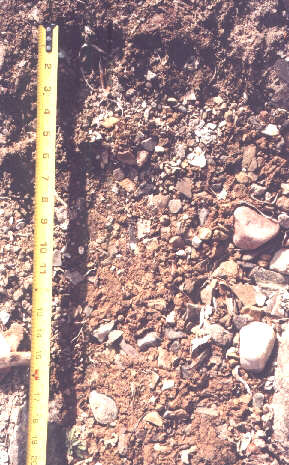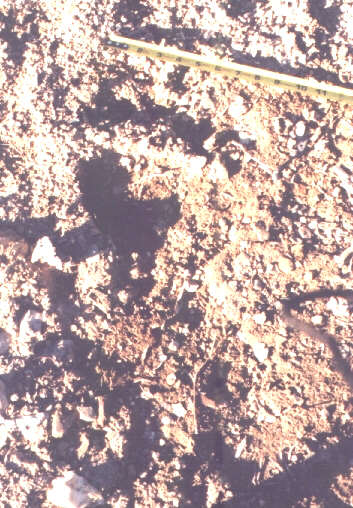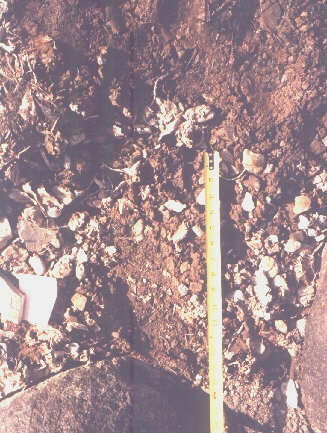
|
||||||||||||||||||
|
|
||||||||||||||||||
|
| ||||||||||||||||||
  






  








| ||||||||||||||||||
|
Geographical Index > United States > Colorado > Eagle County > Report # 1355 Report # 1355 (Class A) Submitted by witness Keith Foster on Wednesday, March 29, 2000. BFRO Investigator, Keith Foster's evaluation of tracks found on the south shore of the Eagle River. App. 1 mile east of the town of Eagle. (Show Printer-friendly Version) YEAR: 2000 SEASON: Spring MONTH: April DATE: 21 STATE: Colorado COUNTY: Eagle County NEAREST TOWN: Gypsum OBSERVED: EAGLE RIVER, COLORADO
The area of the track site is north of White River National Forest and Holy Cross Wilderness. Track site is accessible from two approaches: 1) By wading across the Eagle River 2) By crossing private land or hiking down a steep brushy hillside from a road approximately ½ mile above. The Sheriff himself did not make it to the site until some days after the find because of the difficult access to the site. Bill B. lives about ½ mile west of the site, and fishes that stretch of river often. He mentioned that he has seen only one other fisherman in that area this year. It is not an area used by the public, and therefore an unlikely place for a prankster to leave fake tracks for someone to find. In checking with Forest Service contacts in Colorado I learned that Holy Cross Wilderness Area occasionally receives sighting reports from visitors. There are reports from this area extending back over 100 years, including an 1881 article in the Leadville Chronicle newspaper. Reports made to state and federal government employees in Colorado are typically disregarded and not documented. Overview of the Tracks There were three (3) discernable tracks at the site. They were not consecutive tracks. The labelling of the photos (track 1, track 2, and track 3) represent the order in which they were photographed. Track 1 proceeds in an easterly direction, parallel to the south shoreline of the river. At this point there is an abrupt left turn by the animal, toward the river bank. Track 2 is north of track 1. It is also a right footprint. The intervening left footstep between tracks 1 and 2 is not clearly discernable in the soil, and was not photographed by Bill B. Track 3 is a left footprint -- the next footstep after track 2. The heel-to-heel distance between tracks 2 and 3 is 38 inches. The next footstep after track 3 would have brought the foot down into the river. If the animal had continued in an easterly direction, paralleling the river, for another step or two, it would have walked into some softer soil where tracks would have been much more visible. Apparently it prefered to walk in the frigid river rather than the softer soil ... Some bigfoot investigators have described other track finds where the individual appeared to avoid leaving tracks where possible.
Evaluation of Tracks The most common potential causes were eliminated by visual examination: Human footprints Bear tracks Superimposed human footprints Superimposed bear tracks Hoaxed tracks Tracks of a real animal are distinct from those that a hoaxer would be able to produce. Without revealing all the elements one looks for in trying to identify fake tracks, I can say these tracks had none of the obvious signs, nor any of the more subtle signs. They were clearly produced by real feet on a very large, heavy animal. Misidentified Bear Tracks? Colorado has native black bears. Adult black bears leave tracks about 4.5 inches wide. The toes are arranged in an arc around the front of the foot pad, on both the front and rear feet. The largest grizzly bears in the world -- Kodiak Island (Alaska) bears -- leave tracks up to 8 inches wide at the toes. The shape is roughly similar to those of black bear tracks. The largest Kodiak grizzly tracks are about 14 inches long on the hind foot. Track #2 at the Eagle River site is a bit more than 9 inches wide at the toes, and 18.5 -19 inches long. Only the extinct Short-Faced bear (Artodus Simus) had feet as wide as those at the Eagle River site. The shape of the tracks and pattern of toes at the Eagle River site is somewhat human-like, not bear-like. Hoax? The location of the tracks factors in when evaluating the possibility of a hoax. These tracks were barely noticeable, in a hard-to-reach part of a remote area. Hoaxers put tracks where people will find them. Or they put them in an unlikely place then "discover" them themselves. Bill B. discovered these tracks while fly fishing. He wasn't trying to draw attention to himself. That's why he reported them to the Sheriff's Department, as opposed to the media. The Sheriff Department recommended that he report the matter to the BFRO. Bill B. is a respected businessman in the Vail area. He thought the tracks should be documented by someone, and thus his report. The wildlife officers and law enforcement officers who observed the tracks for themselves, and considered every reasonable alternative, did not believe the tracks were hoaxed.
Track #2 is the clearest track of the three that are discernable. At first it appears to be the track of a giant human, with a foot more than 18 inches in length. It is 18.5 - 19 inches long from the anterior tip of the big toe to the posterior of the pressure ridge left by the heel. The first toe digit (the big toe) soil impression is roughly 2.25 inches wide and 3 inches long. The second toe impression is roughly 1.75 inches wide and 3 inches long. The third and fourth impressions are roughly 1.5 inches wide and 3 inches long. The fifth digit (pinky toe) impression is over 1 inch wide and 2.5 inches long. All five digits appear to have been extended forward to near maximum length in this track. The best and clearest photos of this track show a tape measure laid along the inner edge of the track impression (see photo above). The toe prints are made in a thin layer of decaying vegetable matter overlaying a soil/gravel mixture. In the heel portion of the foot, there is a small ridge of gravel raised at the 12.5 to 14 inch mark that peaks at about 13 inches from the tip of the big toe. This rise that transverses the track is the result of heel strike when the foot is placed during normal walking motion, in that the heel throws up a small pressure ridge of soil material when it comes in contact with the ground. The foot then rolls over and presses down on this ridge, thereby compressing it somewhat. One of the angular stones in this ridge's apex was pushed backward about ¼ inch by the pad after it had been pushed forward by the heel. This is what one expects from a flexing foot in a gentle slow step. Several other subtleties in the soil compression marks show that the tracks were not “drawn” in the ground. Rather, the marks were created by substantial forces from flexible, powerful, articulating feet. Weight calculations based on the track depths and surface areas, comparing the measurements to those of the people who went to the site, show that the animal weighed at least 900 pounds.
I can provide many more details about these tracks to anyone engaged in genuine academic research on this phenomena, or to state or federal wildlife officers. Related Media Articles:
|



